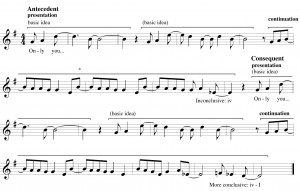I heard this newer song by CeeLo Green the other day and thought, here’s a perfect example of compound thematic/phrase structure. I’m talking about the chorus, which begins around 0:47 in the video here:
Caplin (see Classical Form by William Caplin, Oxford University Press) calls this kind of theme a “compound theme” because it exhibits both sentence and period qualities. To be sure, this is an oversimplification of his theory, but suffice it to say that his “sixteen measure period” is built on a two-measure “basic idea” which forms the basis of a simple sentence. In the sentence, the basic idea is presented, repeated, and then concluded in a four-measure “continuation”. Often, this continuation has the feeling of running away with the basic idea until it hits the cadence. In the compound theme, the sentence is embedded in a period structure such that it happens twice, the first of which (antecedent) ends with a less-conclusive cadence, and the second (consequent) ends with a more conclusive cadence. If you really want to get the details on this concept, see page 65 of Caplin’s book.
A look at the CeeLo Green excerpt below shows something very similar in structure to what Caplin is talking about. Perhaps the only substantive difference in CeeLo’s song is with the cadence types, since CeeLo uses variations on the Plagal cadence both at the end of the antecedent (the phrase ends on a iv chord) and the consequent (ends with iv to I). Regardless, the pairing of less-conclusive followed by more-conclusive is enough to give the impression of a period, even without a dominant.
Note the “*” above a note in the melody. Here you may notice that the pitch is somewhere between a B-natural and a B-flat. This happens several times. I’ve notated it as B-natural only to agree with the harmony, though the note sounds closer to B-flat when CeeLo sings it.
